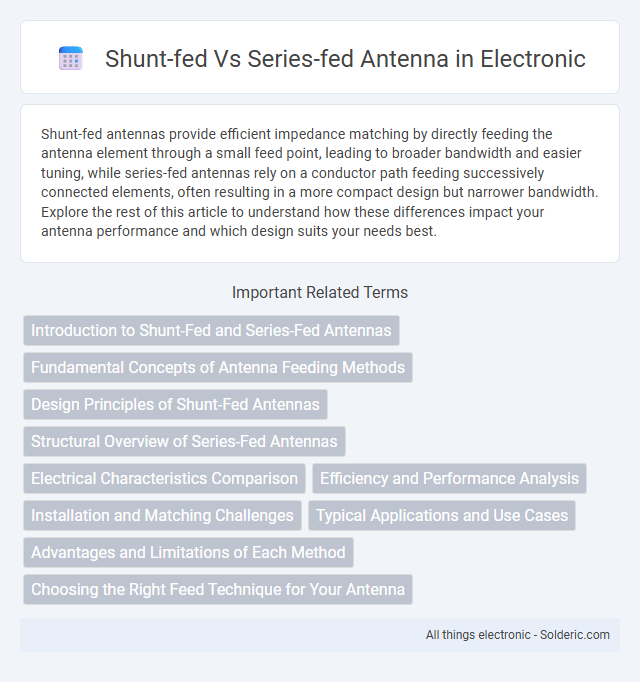Shunt-fed antennas provide efficient impedance matching by directly feeding the antenna element through a small feed point, leading to broader bandwidth and easier tuning, while series-fed antennas rely on a conductor path feeding successively connected elements, often resulting in a more compact design but narrower bandwidth. Explore the rest of this article to understand how these differences impact your antenna performance and which design suits your needs best.
Comparison Table
| Feature | Shunt-Fed Antenna | Series-Fed Antenna |
|---|---|---|
| Feed Mechanism | Connected in parallel (shunt) to the antenna element | Connected in series along the antenna element |
| Impedance Matching | Better for low impedance matching | Better for high impedance matching |
| Common Applications | Used in monopole and ground plane antennas | Used in dipole and Yagi-Uda antennas |
| Complexity | Simple feed design, less components | Requires precise component placement and tuning |
| Bandwidth | Narrower bandwidth due to mutual coupling | Generally wider bandwidth |
| Radiation Pattern | Stable and predictable patterns | Can be affected by feed line positioning |
| Power Loss | Lower feedline loss | Potential for higher feedline loss |
Introduction to Shunt-Fed and Series-Fed Antennas
Shunt-fed antennas use a parallel connection to the feed line, allowing impedance matching with a simple feed point, ideal for compact and efficient designs. Series-fed antennas connect the feed line in series with the antenna elements, offering easier fabrication and consistent current distribution for uniform radiation patterns. Understanding these differences helps you select the appropriate antenna type for specific wireless communication and broadcasting applications.
Fundamental Concepts of Antenna Feeding Methods
Shunt-fed antennas use a connection at a point along the antenna element to feed current, creating a voltage node and allowing for impedance matching without requiring a direct feed at the antenna's end. Series-fed antennas, by contrast, feed current directly at the antenna terminal, providing a straightforward voltage and current distribution but often demanding more precise impedance matching techniques. Understanding these fundamental feeding methods is crucial for optimizing antenna performance, especially in terms of bandwidth, radiation efficiency, and impedance matching in wireless communication systems.
Design Principles of Shunt-Fed Antennas
Shunt-fed antennas operate by connecting the feed line directly to the radiating element via a shunt connection, allowing current flow and excitation through an open circuit segment, which enhances impedance matching and bandwidth. The design principle involves placing the feed point at a location on the antenna where voltage is maximum and current is minimal, typically offset from the driven element's center, to achieve effective excitation without requiring a direct galvanic connection. This approach improves isolation between the feed line and antenna element, reduces feed line radiation, and supports compact antenna designs suitable for applications requiring easement of mechanical constraints and enhanced frequency response.
Structural Overview of Series-Fed Antennas
Series-fed antennas feature elements connected in a linear sequence where each element is fed by the current passed through the previous one, enabling efficient signal distribution along the antenna structure. This configuration typically results in simpler feed networks and reduced feed point impedance, which enhances bandwidth and gain performance. Commonly used in Yagi-Uda and log-periodic antennas, series-fed designs optimize radiation patterns and are favored for directional communication applications.
Electrical Characteristics Comparison
Shunt-fed antennas exhibit high input impedance and require a DC ground path, making them suitable for balanced transmission lines, while series-fed antennas offer lower impedance and simpler matching with unbalanced feeders. The shunt feed method provides better isolation from feed line currents, reducing signal loss and enhancing radiation efficiency. Your choice depends on desired impedance matching and feedline type for optimal antenna performance.
Efficiency and Performance Analysis
Shunt-fed antennas exhibit higher efficiency in compact designs by providing better impedance matching and minimizing resistive losses compared to series-fed counterparts. Series-fed antennas generally suffer from increased insertion loss and reduced radiation efficiency due to the current path through the feeding element, affecting overall performance. Your choice between shunt-fed and series-fed antennas directly impacts signal quality and range, with shunt-fed designs often preferred in applications requiring optimal power transfer and radiation efficiency.
Installation and Matching Challenges
Shunt-fed antennas require precise grounding and proper placement of the feedpoint for effective installation, often complicating the mounting process due to their reliance on a high-impedance feed. Series-fed antennas, by contrast, offer simplified installation with a direct feedline connection but may face impedance mismatch challenges necessitating careful tuning or additional matching components. Understanding these feeding methods can help you optimize antenna performance by selecting the appropriate matching strategy for your specific setup.
Typical Applications and Use Cases
Shunt-fed antennas are commonly used in mobile communication systems, such as vehicle-mounted radios, due to their ease of grounding and compact installation. Series-fed antennas are preferred in base station arrays and high-frequency applications where precise impedance matching and efficient power transfer are critical. Your choice between these types depends on factors like installation constraints and required frequency performance.
Advantages and Limitations of Each Method
Shunt-fed antennas offer advantages such as easier impedance matching and the ability to feed antennas at points not at the end, improving flexibility in installation and design. Series-fed antennas provide simpler construction with direct current flow through the elements, resulting in robust performance and consistent radiation patterns. Your choice depends on application requirements, where shunt-fed suits complex matching needs and series-fed excels in straightforward, efficient setups.
Choosing the Right Feed Technique for Your Antenna
Selecting between shunt-fed and series-fed antennas impacts your antenna's efficiency and impedance matching. Shunt-fed antennas provide a simpler feed point and better bandwidth for certain antenna types, while series-fed antennas often offer improved control over current distribution and radiation patterns. Understanding your specific application's frequency, power requirements, and installation constraints helps in choosing the optimal feed technique for your antenna system.
shunt-fed vs series-fed antenna Infographic

 solderic.com
solderic.com